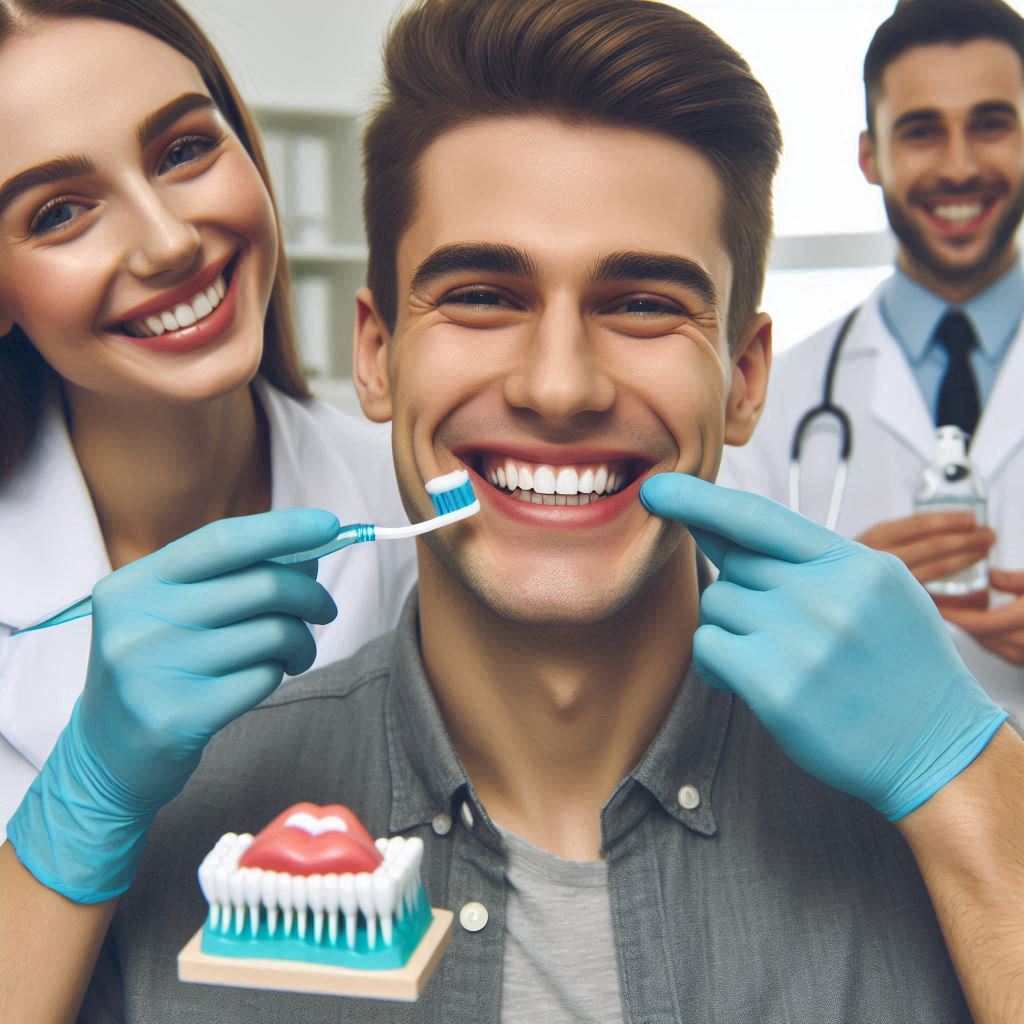As vaping becomes more popular among different demographics, understanding its impact on oral health is essential. While many perceive vaping as a safer alternative to traditional smoking, it still presents significant risks to dental well-being. Vaping involves inhaling vapor from e-cigarettes, which typically contain nicotine, flavorings, and other chemicals. Although it lacks many harmful byproducts of combustion found in conventional tobacco, vaping can lead to various oral health issues. One major concern is dry mouth, or xerostomia, which results from nicotine’s effect on saliva production. This condition increases the risk of cavities and gum disease. Additionally, many e-liquids contain sugars and acids that can erode tooth enamel, leading to further decay. Staining and discoloration of teeth can also occur due to certain flavorings in vape products. To minimize these risks, vapers should practice good oral hygiene, stay well-hydrated, and visit their dentist regularly. Being aware of the potential effects of vaping on oral health is crucial for anyone who vapes, enabling them to take proactive measures to protect their smiles and overall dental health.
Introduction to Vaping
Vaping involves inhaling vapor produced by electronic cigarettes (e-cigarettes) or similar devices. These devices heat a liquid known as e-liquid or vape juice, which typically contains nicotine, flavorings, and other chemicals. While vaping lacks many of the harmful combustion byproducts found in traditional tobacco, it still presents distinct health challenges, particularly for oral health.
The Impact of Vaping on Oral Health
1. Dry Mouth (Xerostomia)
Overview:
One of the most immediate effects of vaping is dry mouth, also known as xerostomia. Nicotine, a prevalent ingredient in many e-liquids, can significantly inhibit saliva production, leading to an arid oral environment. Saliva plays a crucial role in oral health by neutralizing acids produced by bacteria, washing away food particles, and providing protective factors against cavities and infections.
Implications:
A dry mouth can heighten the risk of several dental issues, including:
- Cavities: With reduced saliva, harmful bacteria can thrive, leading to an increased risk of tooth decay. The absence of saliva makes it easier for acids to erode tooth enamel.
- Gum Disease: A dry environment can contribute to inflammation of the gums, increasing the likelihood of gum disease. Symptoms may include redness, swelling, and bleeding, which, if untreated, can progress to more severe conditions.
2. Gum Disease
- Understanding Gum Disease:
Nicotine not only impacts saliva production but also constricts blood vessels, which can impede blood flow to the gums. This reduced circulation slows healing and increases susceptibility to infections. The inflammation caused by nicotine can lead to chronic gum disease, which may manifest in various stages.
- Signs and Symptoms:
Early indicators of gum disease include redness, swelling, and bleeding gums, particularly during brushing or flossing. If left untreated, these initial signs can progress to periodontitis, a more severe condition characterized by deeper gum inflammation and loss of supporting bone. This can ultimately result in tooth loss and may have systemic health implications, including increased risk for heart disease and diabetes.
3. Tooth Decay
- Role of Sugar in E-liquids:
Many e-liquids contain sugars or sugar substitutes that can contribute significantly to tooth decay. Even those labeled as sugar-free can be acidic, which exacerbates enamel erosion. The acidity can weaken tooth enamel, making it more vulnerable to decay and sensitivity.
- Research Findings:
Numerous studies indicate that frequent exposure to sugary substances, including those found in vape juices, correlates with an increased risk of cavities. Regular consumption of these sugary e-liquids can create an environment where harmful bacteria thrive, leading to plaque buildup and subsequent dental issues.
4. Staining and Discoloration
- Staining Mechanisms:
Similar to traditional cigarettes, vaping can lead to staining and discoloration of teeth. The chemical reactions during vaping, particularly with flavored e-liquids, can result in pigmentation that adheres to enamel and causes noticeable discoloration over time.
- Prevention:
To minimize staining, it’s essential to maintain a rigorous oral hygiene routine, including regular brushing and flossing. Additionally, scheduling frequent dental cleanings can help remove surface stains. For those concerned about discoloration, discussing whitening treatments with a dental professional may also be beneficial in restoring a brighter smile.
5. Altered Oral Microbiome
Understanding the Microbiome:
The oral cavity hosts a diverse community of microorganisms that play a vital role in maintaining oral health. This complex ecosystem includes beneficial bacteria that help prevent infections and maintain balance. However, vaping can disrupt this microbial balance, leading to an overgrowth of pathogenic bacteria. The introduction of various chemicals found in e-liquids can alter the composition of the oral microbiome, promoting harmful bacteria while diminishing the presence of protective species.
Consequences of Dysbiosis:
When the oral microbiome is disrupted, it can result in several negative health outcomes, including:
- Halitosis (Bad Breath): The overgrowth of certain bacteria can lead to the production of sulfur compounds, which are responsible for foul-smelling breath. This condition can be socially distressing and impact self-esteem.
- Increased Infection Risk: A dysbiotic microbiome heightens susceptibility to oral infections, such as thrush or periodontal disease. When protective bacteria are outnumbered, harmful bacteria can proliferate, leading to inflammation and other complications.
Strategies for Maintaining Oral Health While Vaping
If you choose to vape, there are several strategies you can implement to help mitigate the risks to your oral health:
1. Stay Hydrated
Importance of Hydration:
Drinking plenty of water is essential for combating dry mouth and stimulating saliva production. Saliva is crucial for neutralizing acids and washing away food particles. Aim for at least eight glasses of water daily, and consider carrying a water bottle to ensure you stay hydrated throughout the day.
2. Practice Good Oral Hygiene
Daily Care:
Maintaining a rigorous oral hygiene routine is vital. Brush your teeth at least twice a day and floss daily to remove plaque and food particles effectively. Using an antibacterial mouthwash can further help reduce harmful bacteria in the mouth, contributing to fresher breath and improved oral health.
3. Regular Dental Visits
Importance of Check-Ups:
Routine dental visits are crucial for monitoring your oral health. Regular check-ups enable dentists to identify early signs of dental issues, such as cavities and gum disease, allowing for prompt intervention and treatment. Aim for at least two visits per year, or as recommended by your dentist.
4. Choose Quality Products
Researching E-liquids:
When selecting e-liquids, prioritize brands that disclose their ingredients and use high-quality components. Avoid products high in sugar or containing harmful additives that can negatively affect oral health. If you have concerns about nicotine, consider exploring nicotine-free options, which may present fewer risks to your teeth and gums.
5. Be Mindful of Flavorings
Choosing Wisely:
Some flavorings in e-liquids may be more detrimental to oral health than others. Opt for less sweet or neutral flavors to minimize the risk of cavities and staining. Certain fruity or dessert-flavored e-liquids can be particularly harmful, as they often contain higher sugar levels and acids that can erode tooth enamel.
6. Consider Alternative Nicotine Sources
Exploring Alternatives:
If nicotine addiction is a concern, explore alternatives such as nicotine replacement therapies, including patches, gum, or lozenges. These methods can help reduce dependency while minimizing risks to your oral health. Consulting with a healthcare professional can provide guidance on the best approach for your situation.
Conclusion
While vaping is often perceived as a safer alternative to traditional smoking, it poses notable risks to oral health. Understanding these risks is essential for anyone who chooses to vape. Vaping can lead to issues such as dry mouth, gum disease, tooth decay, and alterations in the oral microbiome, which may ultimately affect overall health. To mitigate these risks, vapers should adopt proactive strategies. Maintaining good oral hygiene is critical; this includes brushing at least twice a day and flossing daily to remove plaque and food particles. Staying well-hydrated is also important, as it helps combat dry mouth and stimulates saliva production, which protects against cavities. Additionally, scheduling regular dental check-ups enables early detection of any oral health issues, allowing for timely intervention. Consulting with a dental professional is key for personalized advice and insights into the latest research on vaping and its effects on oral health. By taking these proactive measures, vapers can help safeguard their smiles and promote better overall dental health. Being informed and vigilant can make a significant difference in maintaining oral well-being while enjoying vaping.
SOURCES
Borrelli, B., et al. (2020) – The impact of e-cigarette use on oral health. Journal of Dental Research, 99(10), 1122-1129.
Donnelly, C., et al. (2018) – The relationship between sugar intake and dental caries. American Journal of Dentistry, 31(4), 194-200.
Friedman, M., et al. (2020) – Vaping and the oral microbiome: A potential health risk. Oral Diseases, 26(6), 1444-1450.
González-Moles, M. Á., et al. (2020) – The impact of vaping on dental aesthetics. Journal of Cosmetic Dentistry, 36(1), 28-35.
Haffajee, A. D., & Socransky, S. S. (2016) – Gum disease: A historical perspective. Periodontology 2000, 70(1), 7-16.
Hesse, M., et al. (2017) – Hydration and oral health: A review. International Journal of Dentistry, 2017, Article ID 8534391.
Khan, M. I., et al. (2019) – Teeth whitening: Current perspectives. Journal of Clinical Dentistry, 30(1), 4-9.
Khattak, S. F., et al. (2021) – The effects of nicotine on periodontal health: A review. Journal of Periodontology, 92(7), 1006-1015.
Klein, E. G., et al. (2018) – Nicotine replacement therapy and oral health: A systematic review. Tobacco Control, 27(6), 682-689.
McGill, J., et al. (2022) – The effects of flavored e-cigarettes on oral health. Journal of Public Health Dentistry, 82(2), 105-112.
Mello, M. A., et al. (2022) – Regular dental check-ups and oral health outcomes. BMC Oral Health, 22(1), 210.
Meyer, H., et al. (2021) – Impact of e-cigarettes on oral health. Oral Health & Preventive Dentistry, 19(3), 253-260.
Rosenberg, M., et al. (2020) – Daily oral hygiene practices and their influence on oral health. International Journal of Dental Hygiene, 18(2), 143-150.
Schmidt, A. M., et al. (2018) – Salivary flow rates in relation to oral health. Journal of Clinical Periodontology, 45(10), 1116-1123.
Sharma, S., et al. (2022) – Acidic environments in the mouth: The role of vaping. Clinical Oral Investigations, 26(2), 829-838.
Sullivan, S. K., et al. (2021) – E-cigarette product ingredients and oral health: An overview. Tobacco Control, 30(1), 56-63.
HISTORY
Current Version
October 18, 2024
Written By:
SUMMIYAH MAHMOOD




